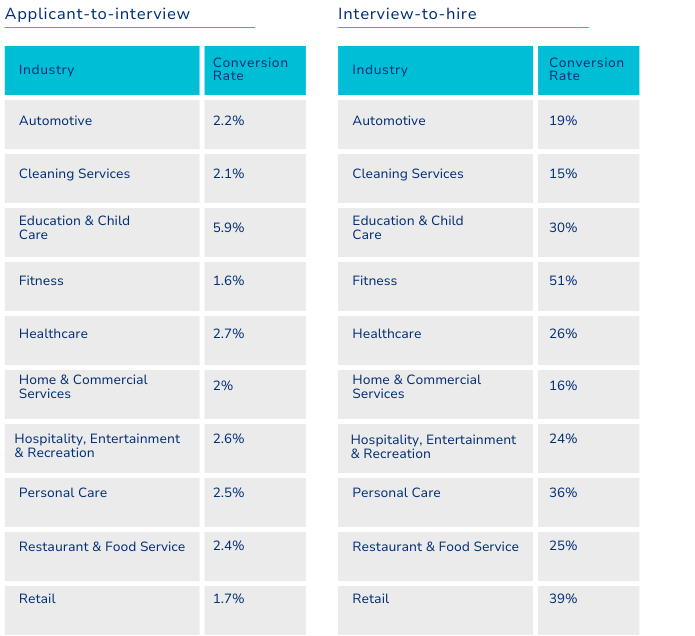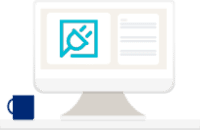In CareerPlug’s sixth annual Recruiting Metrics Report, we continue to analyze our hiring data to shed light on hiring metrics and trends for small businesses across various industries. Our team analyzed hiring activity in 2024 from more than 60,000 small business owners — covering more than 10 million job applications.
In this report, you will find analysis of data covering the hiring funnel from initial job posting through hire, organized by industry.
This report will establish industry-level benchmarks for key hiring metrics, including:
- Average click and application rates
- Conversion rates from click to application, from application to interview, and from interview to hire
- The number of applicants typically needed to make one hire
- The average time it takes to contact applicants — and how long it typically takes to contact a hire
- The top sources for applicants and hires
- The times of the year that are most likely to produce the highest application rates
Take an in-depth look at the results of our study by downloading the free 2025 Recruiting Metrics Report.

2025 Recruiting Metrics: Benchmark Data by Industry
See how your company’s hiring and recruiting stats compare to others in your industry and learn tips for what you can do to make the right hires.
DOWNLOAD THE REPORTThe Labor Market of 2024
The 2024 hiring and labor market was marked by economic uncertainty, persistent labor shortages in key industries, and evolving workplace expectations. While job growth has slowed compared to the rapid post-pandemic recovery, unemployment has remained relatively low.
Employers continue to struggle with retention, particularly in sectors like healthcare, hospitality, and skilled trades, leading to a stronger emphasis on onboarding and employee engagement.
AI-driven hiring solutions have gained traction, streamlining recruitment while raising concerns about bias and fairness. Additionally, a shift toward skills-based hiring has helped companies expand talent pools, reducing reliance on traditional degree requirements.
Employee retention starts with a strong hiring process. We hope that the hiring data in our latest Recruiting Metrics Report empowers small businesses with insights and advice on how they can better shape their hiring practices to make the right hires.
Key Recruiting Metrics
In analyzing the data, we found that the following metrics revealed the most significant takeaways.
Clicks-to-apply rate
In 2024, the click-to-apply conversion rate averaged 6% across all industries, dropping just slightly from last year. Even though many businesses slowed down hiring, this suggests there were still quite a lot of opportunities for job seekers to choose from.
Applicant-to-interview ratio
The applicant-to-interview ratio in 2024 was 3%. This means that on average, for every 100 applicants a job posting received, 3 of those applicants were invited to interview for the role. This is a lower number than employers would like to see, and oftentimes can be a sign of unqualified candidates or interview ghosting plaguing the hiring process.
Interview-to-hire ratio
The interview-to-hire ratio in 2024 was 27%. This is down slightly from last year, but when you consider that just 2% of applicants were invited to interview in the first place, having an interview-to-hire conversion rate of 26% means that employers are far more efficient later in the hiring process.

Applicant-to-hire ratio
In 2024, employers received an average of 180 applicants for every hire they made. However, this figure varied widely across industries, with employers in the automotive industry seeing around 234 applicants per hire, while employers in education & childcare saw 57.
What are the best times of year to post jobs?
We saw a fairly steady rate of applicants month over month. There was a spike in applicant counts in June. With the end of the year, also seeing an increase in the number of applicants.
Where are the best places to post jobs?
Job boards are the most common source for applicants, producing an average of 60% of applications across all industries in our analysis. If absolute volume is your goal, posting your job to job boards is your best bet. But despite being the source of most applicants, job boards do not produce hires at nearly the same rate as other sources.
Job boards produce quantity, but not always quality
The reasons for these stark differences in applicant-to-hire ratios based on source may vary, but our experience shows us that applicants who apply from job boards are more likely to be sending out dozens applications in short order, with less consideration for their qualifications for the role or their interest in the specific job.
An applicant who takes the time to research a role and apply directly through a company careers page is more likely to have spent time considering their own fit for the role and the company, and an applicant who is referred to a job by an employee is much more likely to be familiar and engaged with your employer brand. And while custom sources vary among industries, employers that use them consistently find high-quality candidates they may not have found on the major job boards.
How to Improve Your Hiring in 2025
1. Build your employer brand and showcase it on your careers page.
Company careers pages are a hugely successful source of hires, but an underutilized source of applicants overall. Candidates who take the time to research a company tend to be high-quality candidates who are more selective about where they choose to apply. Invest in creating an engaging and attractive careers page that showcases employee testimonials, aspects of your company culture, and your core values.
2. Create a job marketing strategy that doesn’t rely on job boards.
Compile a list of custom sources like industry-specific job boards, community message boards, local and university job boards, and email campaigns to customers. Compile another list of employees, friends, and colleagues in your personal network to reach out for referrals. Our data shows these sources produce the highest-quality candidates, yet the lowest percentage of applicants. Plan on targeting them before your next round of hiring.
3. Develop a passive recruiting strategy so you don’t miss out on great candidates.
Many industries missed out on the highest applicant volume. At CareerPlug, we have a saying, “Always be hiring.” This refers to creating a passive recruiting strategy, where you have a pipeline of ideal candidates waiting in the wings. This can look like storing the contact information of candidates you were impressed by but didn’t hire and posting a job to your careers page or website that’s labeled as a “future opening” so you can accept applications all year long.
4. Communicate with candidates faster.
Our data shows that over the last 3 years, small businesses have been speeding up their hiring processes as competition in the labor market increases. In 2025, you’ll want to move fast before your competition scoops up quality candidates. Try text recruiting to communicate with candidates faster. Text messages receive an 8 times higher response rate than email, along with a much faster response time. An applicant tracking system like CareerPlug can also help you quickly evaluate candidates using a proven hiring process, allowing you to accelerate your hiring decisions without sacrificing quality.
5. Use hiring software with automations to reduce candidate ghosting.
One major pain point that employers report year after year is an increase in candidate ghosting – when candidates stop responding to businesses after submitting an application and drop out of the hiring process without explanation. Candidate ghosting can lead to low applicant-to-interview conversion rates. Consider using automated interview scheduling software to instantly engage high-quality candidates early in the hiring process, while also identifying unengaged applicants you shouldn’t waste your time on.
6. Onboard better to improve new hire retention
A strong onboarding process sets the tone for employee success and long-term retention. New hires who feel welcomed, supported, and prepared are more likely to stay with your company.
Streamline onboarding by providing clear expectations, structured training, and early engagement opportunities. Automate paperwork and task reminders to reduce administrative burden and focus on building connections. Investing in a great onboarding experience not only boosts retention but also accelerates productivity — ensuring new hires contribute to your business faster.

Simplify Hiring with CareerPlug
Need to improve your own recruiting metrics? CareerPlug makes it easy. Our hiring and retention software comes with the tools you need to attract applicants, make better hiring decisions, and engage your team. Take a tour of our software to learn more!
GET A DEMO